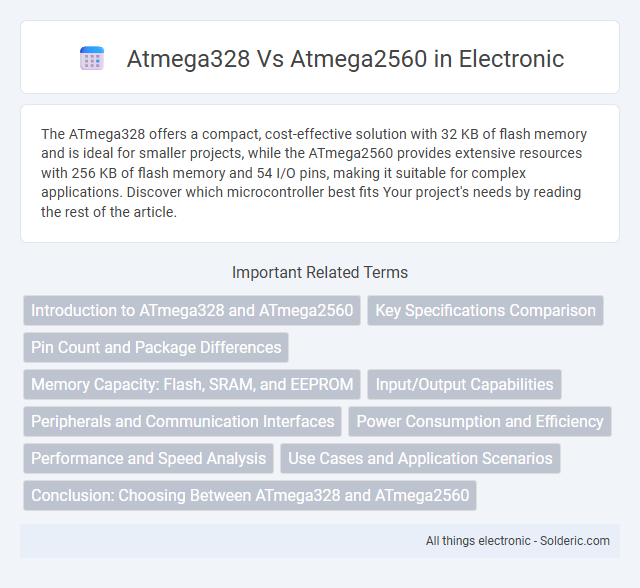The ATmega328 offers a compact, cost-effective solution with 32 KB of flash memory and is ideal for smaller projects, while the ATmega2560 provides extensive resources with 256 KB of flash memory and 54 I/O pins, making it suitable for complex applications. Discover which microcontroller best fits Your project's needs by reading the rest of the article.
Comparison Table
| Feature | ATmega328 | ATmega2560 |
|---|---|---|
| Architecture | 8-bit AVR | 8-bit AVR |
| Flash Memory | 32 KB | 256 KB |
| SRAM | 2 KB | 8 KB |
| EEPROM | 1 KB | 4 KB |
| Operating Voltage | 1.8 - 5.5 V | 4.5 - 5.5 V |
| Max Clock Speed | 20 MHz | 16 MHz |
| Digital I/O Pins | 23 | 54 |
| PWM Channels | 6 | 15 |
| ADC Channels | 6 | 16 |
| USART | 1 | 4 |
| SPI | 1 | 1 |
| I2C (TWI) | 1 | 1 |
| Package | 28-pin DIP, TQFP | 100-pin TQFP |
Introduction to ATmega328 and ATmega2560
ATmega328 and ATmega2560 are microcontrollers developed by Atmel, now part of Microchip Technology, widely used in embedded systems and Arduino platforms. The ATmega328 features 32KB of flash memory, 2KB SRAM, and 23 I/O pins, making it suitable for smaller projects requiring efficient performance. The ATmega2560 offers 256KB flash memory, 8KB SRAM, and 86 I/O pins, ideal for complex applications demanding extensive memory and numerous input/output interfaces.
Key Specifications Comparison
The ATmega328 features 32 KB of flash memory, 2 KB of SRAM, and 1 KB of EEPROM, while the ATmega2560 offers 256 KB of flash memory, 8 KB of SRAM, and 4 KB of EEPROM, enabling more complex program management. Clock speed for both microcontrollers maxes out at 16 MHz, but the ATmega2560 includes 86 GPIO pins compared to the ATmega328's 23, supporting larger and more intricate hardware setups. In terms of peripherals, the ATmega328 provides 3 timers and 6 PWM channels, whereas the ATmega2560 boasts 6 timers and 15 PWM channels, giving enhanced timing control for advanced applications.
Pin Count and Package Differences
The ATmega328 features 28 pins in a compact DIP or TQFP package, suitable for simpler projects with fewer I/O requirements, while the ATmega2560 offers a robust 100-pin TQFP package designed for advanced applications demanding numerous I/O ports. Your choice depends on the complexity of your design, as the ATmega2560 supports more peripherals and pins for expandability. Pin count and package differences significantly impact PCB layout and overall project scalability.
Memory Capacity: Flash, SRAM, and EEPROM
The Atmega328 features 32KB of Flash memory, 2KB of SRAM, and 1KB of EEPROM, providing a compact solution for moderate program sizes and data storage. In contrast, the Atmega2560 offers 256KB of Flash, 8KB of SRAM, and 4KB of EEPROM, significantly expanding capacity for complex applications requiring larger codebases and extensive runtime data. This substantial memory enhancement in the Atmega2560 supports more advanced firmware, multitasking, and persistent data handling compared to the Atmega328.
Input/Output Capabilities
The ATmega328 microcontroller features 23 programmable I/O pins, suitable for smaller projects requiring moderate peripheral connectivity. In contrast, the ATmega2560 offers 86 programmable I/O pins, providing extensive flexibility for complex applications involving multiple sensors, actuators, and communication interfaces. This significant difference in I/O capabilities makes the ATmega2560 ideal for advanced embedded systems demanding high pin count and diverse input/output control.
Peripherals and Communication Interfaces
The ATmega328 features 23 programmable I/O lines, one 10-bit ADC, and limited communication interfaces including one UART, SPI, and I2C, making it suitable for compact applications. The ATmega2560 offers an extensive array of peripherals with 86 programmable I/O lines, four UARTs, six 10-bit ADC channels, and multiple SPI and I2C interfaces, providing enhanced communication and connectivity options for complex projects. Your choice depends on the need for peripheral flexibility and multiple simultaneous communication channels.
Power Consumption and Efficiency
The ATmega328 features lower power consumption with active current typically around 9 mA at 16 MHz, making it ideal for battery-operated devices requiring efficiency. The ATmega2560 consumes higher power, approximately 16 mA at 16 MHz, due to its expanded I/O ports and memory capacity. Power-saving modes in both microcontrollers, such as sleep and power-down modes, enhance energy efficiency for various application demands.
Performance and Speed Analysis
The Atmega328 runs at a maximum clock speed of 20 MHz, providing efficient performance suitable for simpler embedded projects, whereas the Atmega2560 supports up to 16 MHz but excels in handling complex tasks with its higher memory and multiple I/O pins. Your choice depends on whether your application prioritizes raw speed or multitasking capability and larger code space, with the Atmega328 offering slightly faster clock speed but the Atmega2560 delivering superior overall system performance for advanced applications. Benchmark tests show the Atmega2560's architecture optimizes data throughput despite a marginally lower clock rate, making it ideal for performance-demanding projects.
Use Cases and Application Scenarios
The Atmega328 excels in compact projects like Arduino Uno-based IoT devices, wearables, and simple robotics due to its smaller memory (32KB flash, 2KB SRAM) and fewer I/O pins (23). The Atmega2560, with 256KB flash memory, 8KB SRAM, and 86 I/O pins, suits complex applications such as 3D printers, advanced robotics, and large-scale automation systems requiring extensive peripherals. Your choice depends on project scale and resource demands, where the Atmega2560 offers greater flexibility for intricate and resource-heavy tasks.
Conclusion: Choosing Between ATmega328 and ATmega2560
The ATmega328 is ideal for simple, cost-effective projects requiring moderate I/O pins and memory, such as Arduino Uno applications. The ATmega2560 offers extensive memory (256 KB Flash, 8 KB SRAM), more digital and analog pins, and advanced features suitable for complex, multi-functional projects like Arduino Mega. Selecting between the two depends on project complexity, memory needs, and I/O requirements, with the ATmega328 favoring compactness and the ATmega2560 enabling scalability.
atmega328 vs atmega2560 Infographic

 solderic.com
solderic.com